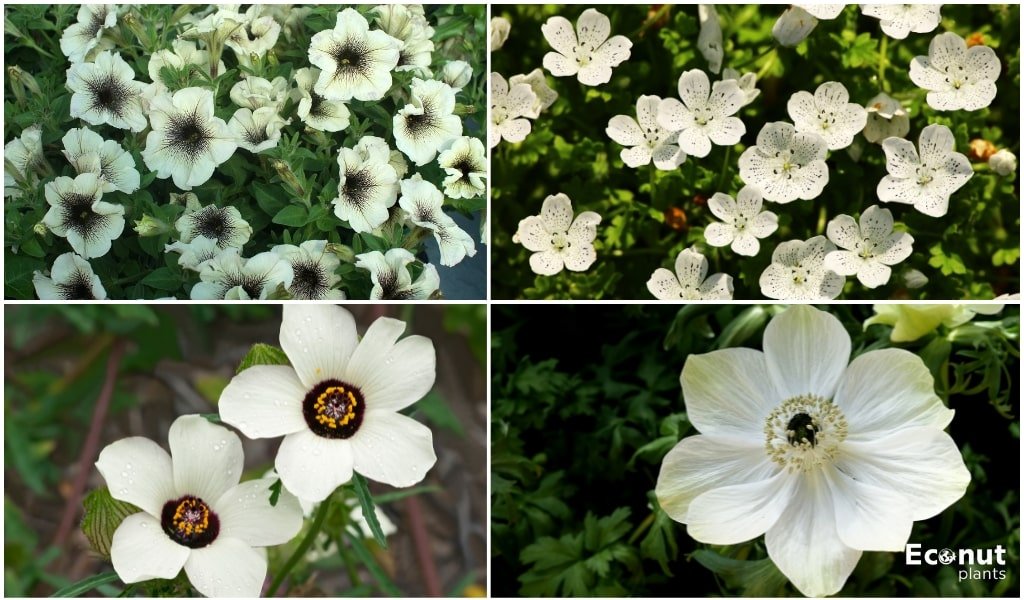For your garden, are you searching for unusual colours and an eye-catching contrast? Then your list has to start with black and white flowers!
Black and white flowers are sure to entice you if you enjoy flowers that don’t stick to their typical colours! These are their best types.
1. White Bat Flower
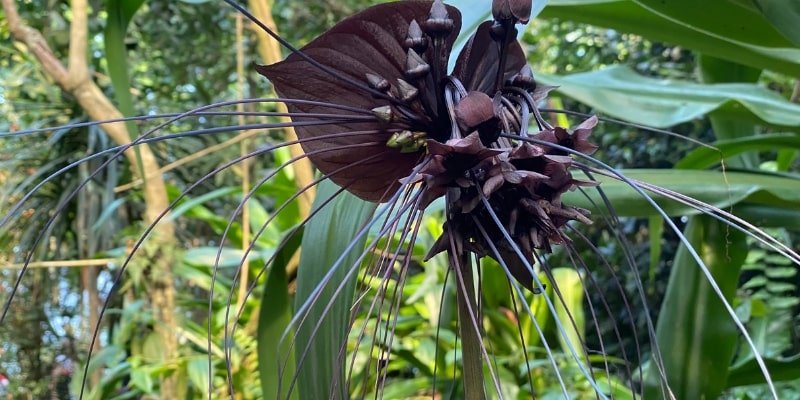
Scientific Name: Tacca integrifolia
Plant Type: Well Rooted Plant
Plant Size: 2–4 ft tall
Sun Exposure: Full sun
The largest blooming Tacca plant is the white bat plant, which is distinguished by its long, whiskered, purplish-white blossoms that are six to eight inches across. For their rich green leaves, they are also grown as decorative plants. Bat plants grow easily in medium- to low-light environments and make a really bizarre specimen plant for the house.
2. Anemone Carmel White

Scientific Name: Anemone coronaria ‘Carmel White’
Plant Type: Perennial
Plant Size:10-16″
Sun Exposure: Full Sun or Partial Sun
With a black circular core that pops against white petals, anemones’ vibrant blossoms resemble poppies. These flowers are a good choice for container gardening because it’s easy to get lovely buds from them.
These unusual flowers are perennials that defy deer and are simple to grow. Their watering requirements are average, so you’ll just need to water them once a week or so.
These make excellent choices for arrangements if you’re looking for a flower to cut. Any bouquet is enhanced by the dramatic contrast between their strong black cores and white buds.
3. Black Eyed Susan Vine
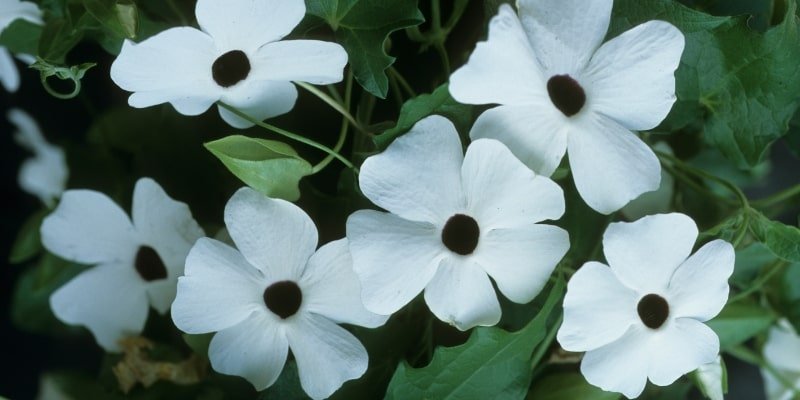
Scientific Name: Thunbergia
Plant Type: Perennial
Plant Size: 24 to 36 inches tall
Sun Exposure: Full Sun
The Black Eyed Susan vine is an exotic-looking climber with a very dark, nearly black, circular splotch in the middle, rather than the well-known daisy Rudbeckia hirta. Nevertheless, one specific cultivar known as “Susie White” has genuine snow white surrounding it, whereas the majority of types have warm colours (pale orange, pink, and red)!
The black-eyed Susan vine, also known as “Susie White,” is a fantastic option for creating a night and day effect on a green background when it comes to hanging baskets, trellises, arbores, and fences. Despite its exotic and delicate appearance, it will go well with Mediterranean and tropical-style gardens as well as more conventional ones, such as an English country estate or cottage.
4. Crazytunia Black and White
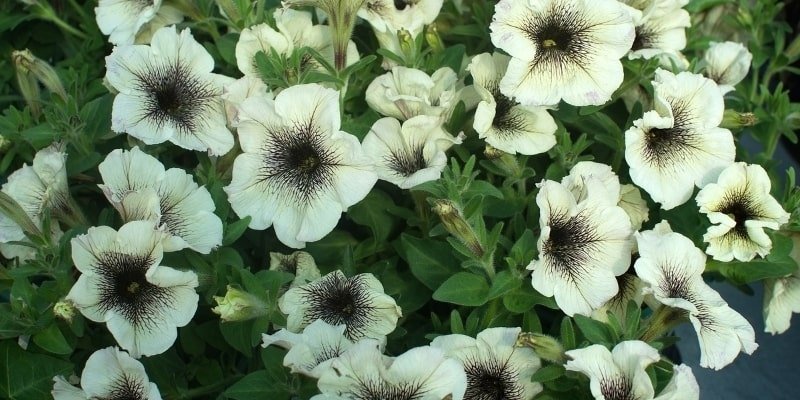
Scientific Name: Petunia hybrida ‘Crazytunia Black&White’
Plant Type: Annual
Plant Size: 8-10″
Sun Exposure: Full Sun
The amazing Crazytunia Black and White variety features contemporary black and white flowers. Large blooms with centers of deepest black and tints of brilliant white are present.
Crazytunia Black and White is perfect for patio pots and containers, as well as hanging baskets. It is resistant to deer and draws hummingbirds and butterflies. By removing dangerous air pollutants like formaldehyde and benzene, it also enhances the quality of the air.
5. Flower-of-an-Hour
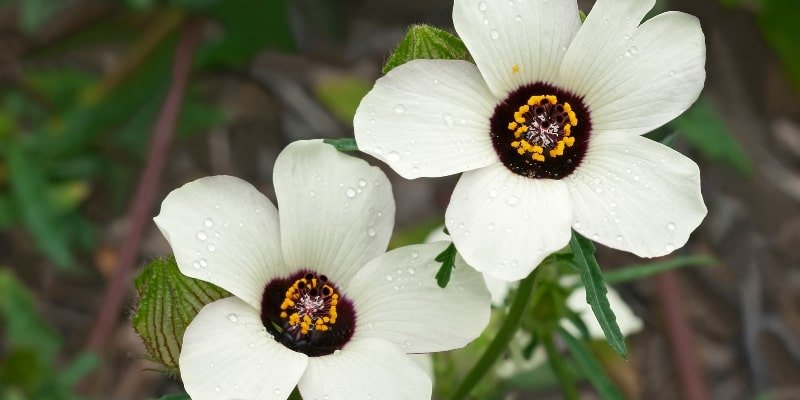
Scientific Name: Hibiscus trionum
Plant Type: Annual
Plant Size: 12-36
Sun Exposure: Full Sun
Though it’s commonly planted as an annual, hibiscus flower of the day is technically a perennial in frost-free regions. Between July and early autumn, it blooms, forming a tidy mound that is 18 to 24 inches (46 to 61 cm) tall. Insects that feed on nectar, such as butterflies and bumblebees, flock to the blooming plant to pollinate its blossoms.
Blossomed seedpods emerge in their location after flowering. When fully mature, they open, releasing a plethora of seeds all over the garden. As an invasive species in Washington and Oregon, the plant has the potential to become weedy.
6. Oriental Poppy ‘Royal Wedding’
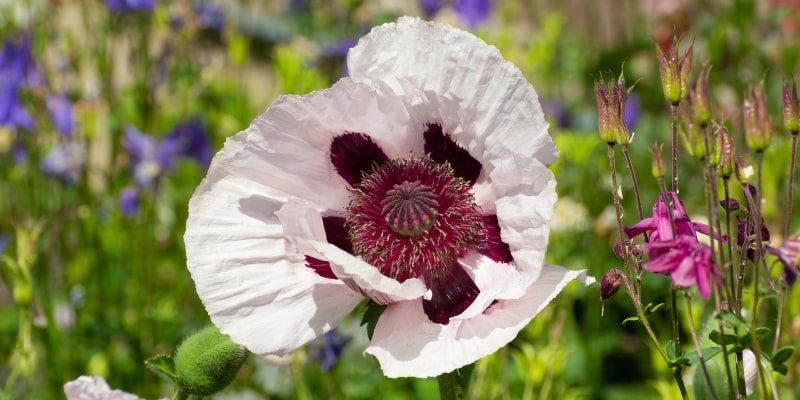
Scientific Name: Papaver orientale ‘Royal Wedding’
Plant Type: Perennial
Plant Size: 24-36
Sun Exposure: Full Sun
Oriental poppies are ephemerals that bloom in the spring on stems covered in delicate hairs and have robust leaves. They fade away to make way for summer-blooming annuals after their brief but spectacular June bloom, only to resurface later in the summer to produce more foliage. The blossoms of “Royal Wedding” are pure white satiny with coal black lacquer at the cores.
7. Pansy Giant White Black Face
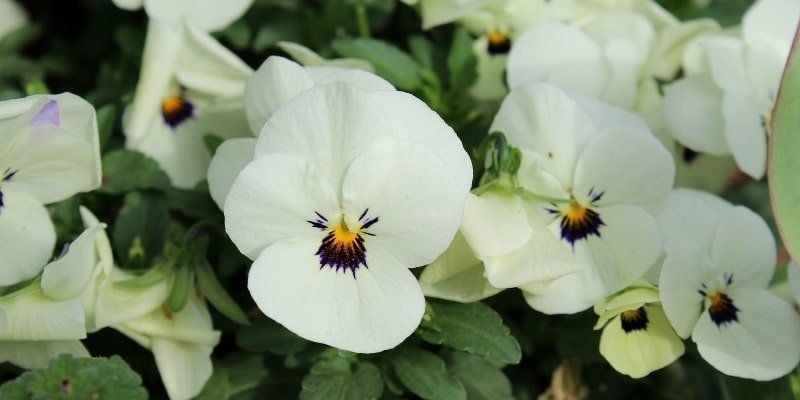
Scientific Name: Viola tricolor var. hortensis
Plant Type: Annual
Plant Size: 6-9
Sun Exposure: Full Sun
The petals of Pansy Giant Black are black with a golden center. Pansies are the most widely available flower and are available in the most colours. Their cheery, colourful faces give any garden personality and colour.
Planting pansies in the fall will ensure that they bloom throughout the winter and spring, as they like the cooler weather. Removing deadheads from the plants can encourage additional blossoms. Pansies are very adaptable and can be mass-planted for a sea of cheery, smiling faces, or put in pots, baskets, or as borders.
Large, gaudy facial markings are characteristic of pansies. The Royal Horticultural Society has awarded the Joker Series its Award of Garden Merit. Well-draining soils with sunny or partly sunny locations are ideal for plant growth.
8. Nemophila Snowstorm
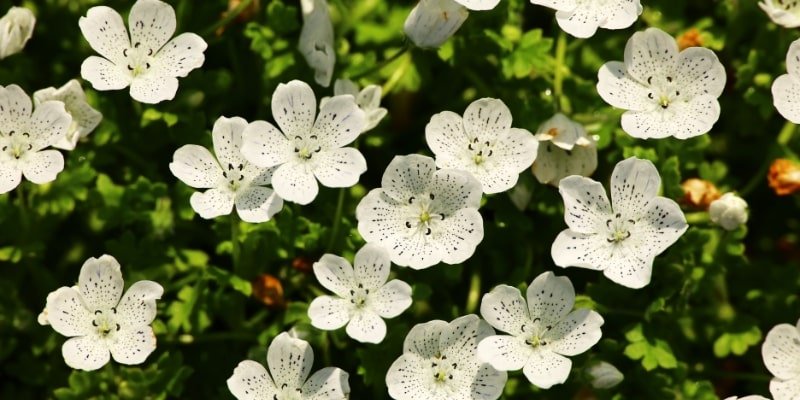
Scientific Name: Nemophila menziesii
Plant Type: Perennial
Plant Size: 4
Sun Exposure: Full Sun or Partial Sun
Nemophila Snowstorm has smaller flower buds and is a short, black and white flower. There is a flash of darkness emanating from the center of the delicate white petals. They have a striking, distinctive dotted look.
These are a great choice for early-blooming pollinators in the area as the season gets underway. To display their bright features, they want to be in places where there is a plenty of sunlight.
These tiny blossoms go well with any other small ground flower and can really fill up a container. Including a variety of types might add even more blue hue.
9. Pantaloons Foxglove
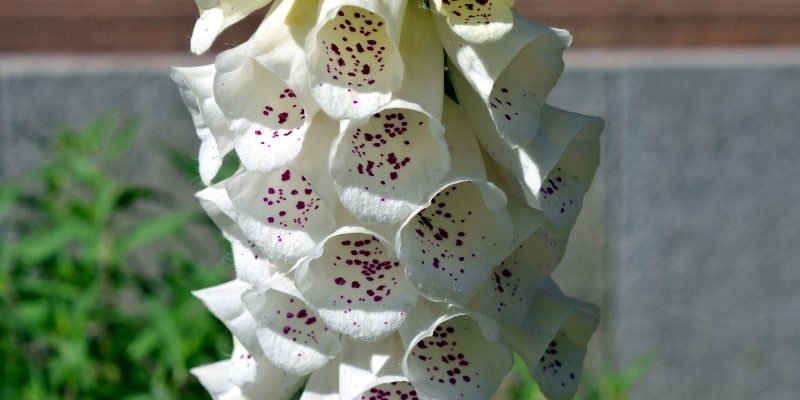
Scientific Name: Digitalis purpurea ‘Pam’s Split’
Plant Type: Perennial
Plant Size: 36-48″
Sun Exposure: Partial Sun
Pantaloons A type of flower known as foxglove has huge white blossoms that divide the flower into four equal curtains along its sides. The petals show deep maroon inner patches when they flutter in the breeze. The well-branched, compact plants bloom for several weeks in late spring or early summer, reaching heights of 3-5 feet. They are zone-hardy for the winter.
10. Sappho Rhododendron

Scientific Name: Rhododendron ‘Sappho’
Plant Type: Perennial
Plant Size: 72-96
Sun Exposure: Full Sun to Partial Sun
The juxtaposition of white and black, light and darkness, that the “Sappho” rhododendron presents on its enormous flowers makes it one of the most beautiful kinds you will ever own.
You can also grow it in the dappled shadow of trees and woodland gardens. Grow it as an accent shrub or mix it in with other bushy plants in hedges. The majority of casual designs, even oriental ones, can use it.
11. White Hot Spot Lily

Scientific Name: Lilium ‘White Hot Spot’
Plant Type: Perennial
Plant Size: 10-12″
Sun Exposure: Full Sun
The White Hot Spot Lily’s striking blooms are frequently used as cut flowers. Each stem produces three to five large flowers that look amazing in bouquets and gardens alike.
Like other Asiatic lilies, the White Hot Spot grows in the same way. They require at least six hours of direct sunlight, as they adore it. For added benefit of keeping their roots cold, plant them near low-growing perennials.
A vital aspect of the soil used to grow lilies is drainage. It ought not to withstand the pressure. The best soil is highly supplemented with organic materials.
The striking blossoms emerge in the early to midsummer. In the winter, keep an eye out for pests like deer. Before the flowers cause the stalk to become too heavy, you might need to stake your lilies.
12. ‘Supertunia Latte’ Petunia
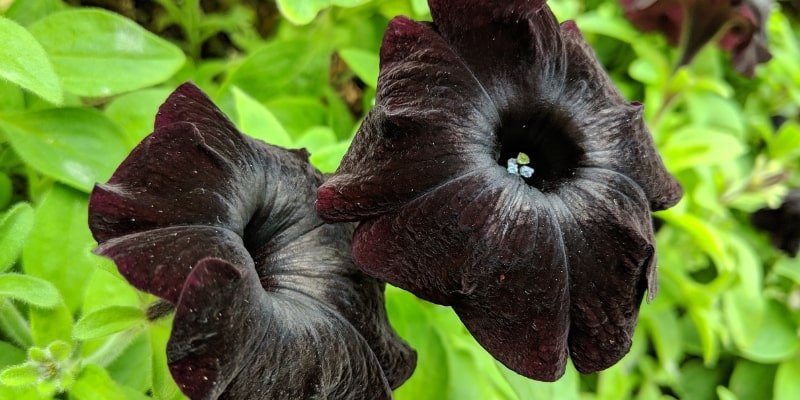
Scientific Name: Petunia hybrid
Plant Type: Annual or Perennial
Plant Size: 10-12″
Sun Exposure: Full Sun and partial shade
Due to their easy care and long blooming season, petunias are a popular choice for gardens. And if you enjoy black-and-white flowers, “Supertunia Latte” is the one you should get.
Large, milk-coloured blooms with a strikingly dark, blackish-purple core will be produced in vast quantities throughout the season on this mounding cultivar. An intricate network of veins allows this to expand outward, and the overall effect is very striking!
‘Whestoff Crazytunia Black and White’ is a comparable type that is even harder to differentiate from our cultivar; however, the black variety may tend to show off its plum undertone more readily and provide a less dependable effect.
13. Asian Pear Flowers
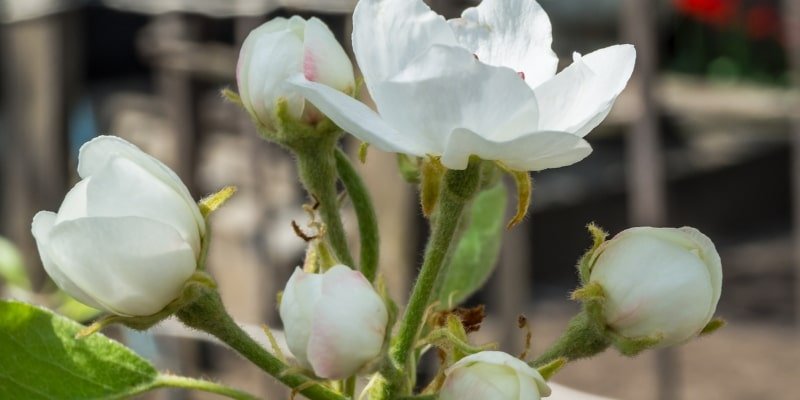
Scientific Name: Pyrus pyrifolia ‘Shinseiki’
Plant Type: Perennial
Plant Size: 10-30 ft. tall, 6-30 ft. wide
Sun Exposure: Full sun
White and fragrant, Asian pear blossoms appear in late February and early April. Both male and female components are present in the terminal clusters of flowers. They need cross-pollination to set fruit because they are essentially self-incompatible.
14. ‘Big Bang’ Lily

Scientific Name: Lilium ‘Big Bang’
Plant Type: Perennial
Plant Size: 48
Sun Exposure: Full Sun or Partial Shade
One of the few lilies that truly lives up to its name is the Big Bang Lily, a gorgeous flower with a dark burgundy to black centre erupting onto white petals. “Big Bang” is a type of lily that is generally easy to grow.
It’s as dark as some flowers get; however, it’s not always a genuine black; the contrast of the dark hue with the pale petals makes it look like. These lovely buds feature prominent stamens and may also have a pink tint.
The striking blooms may also have a strong scent. You’ll be able to enjoy these perennial Big Bang Lilies for many years to come if you plant some. They’ll be a fantastic mainstay for annual floral cuttings.
15. Black Widow
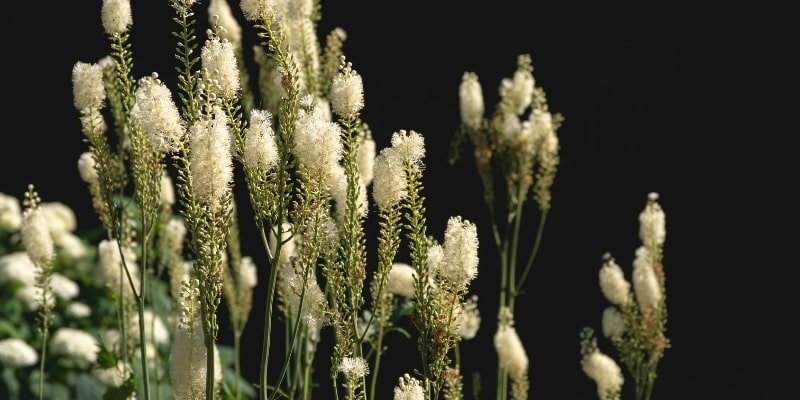
Scientific Name: Geranium phaeum
Plant Type: Perennial
Plant Size: 24-36
Sun Exposure: Full Sun or Partial Shade
The Black Widow Geranium, sometimes referred to as a Mourning Widow, has dazzling white centres and dark, drooping petals. They often grow in dense clumps and can get rather tall.
Occasionally, providing these plants with support during their growth will help prevent them from drooping. They can survive in direct sunlight, although they will gravitate towards areas with some shade. These could be the solution if you’re looking for a hardy flower for the area.
In addition, a lot of butterflies visit the garden because of these blooms. They are resistant to deer and rabbits, even though they attract pollinators. With little effort, these blooms deliver a lot.
16. False Shamrock
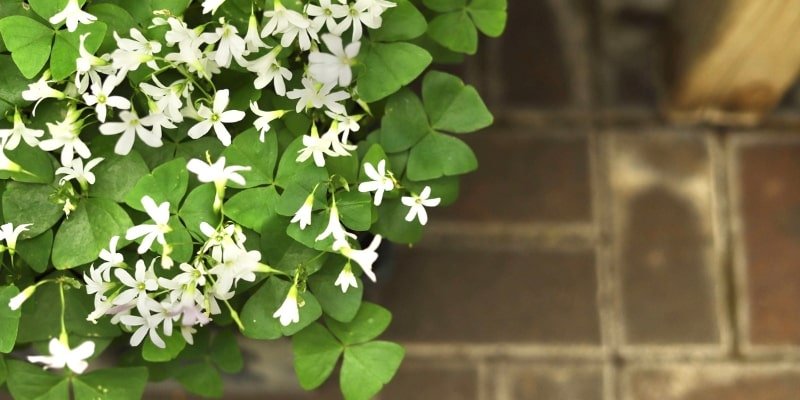
Scientific Name: Oxalis triangularis
Plant Type: Perennial
Plant Size: 6-12
Sun Exposure: Full Sun or Partial Shade
The term “false shamrock” comes from the enormous foliage that resembles shamrocks and grows in three leaves. The leaves might be a rich maroon-black colour, variegated, or a standard green. White flowers sprout from the foliage.
This floral plant grows well in containers or makes excellent border plants. The foliage is resilient and resistant to deer, and the vibrant buds should draw some butterflies.
False shamrocks can need additional assistance while they’re flowering, but it’s best to give them time to dry between watering.
17. Hillside Black Beauty
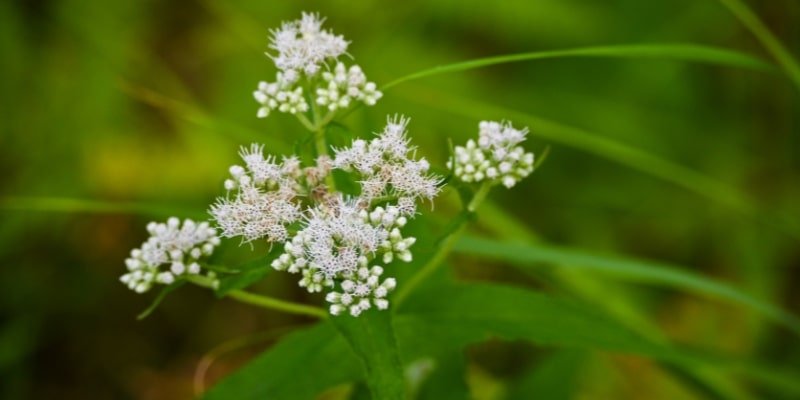
Scientific Name: Actaea simplex
Plant Type: Perennial
Plant Size: 48-60
Sun Exposure: Partial Sun or Full Shade
These plants have striking black leaves and tall white blossoms. With its vibrant flowers and dense ground cover, the Hillside Black Beauty may be a wonderful addition to any landscape to help create more space.
The white flowers grow on tall rods from late summer to early autumn. Their aroma is sweet and aromatic, drawing in lots of butterflies and birds. Another common name for these plants is bugbane, which deters bothersome insects.
It’s better to keep perennial plants in shady parts of the garden because they will return year after year. Although they typically don’t have many pest problems, keep an eye out for leaf rust.
18. Onyx Odyssey Hellebore

Scientific Name: Helleborus x hybridus
Plant Type: Perennial
Plant Size: 18-22
Sun Exposure: Partial Sun to Full Shade
One striking bloom is the Onyx Odyssey. The hellebore hybrid features petals that are deep black to nearly black and purple, encircling a centre that is either white or yellow. The bloom has petals that are sharper than those of a rose.
The ideal growing conditions for these black flowers with white outlines are semi-shaded to completely shaded locations. There is an abundance of dense, evergreen foliage covering their towering buds. Early in the spring, some of their black buds will open first.
They should self-seed and produce beautiful buds that come back each year. Even though Onyx Odyssey Hellebore might cause moderate irritation to the skin, it is best to handle it with appropriate skin protection to avoid poisoning humans or any pets. They can make a wonderful addition to the garden with careful maintenance.
19. Penny Black
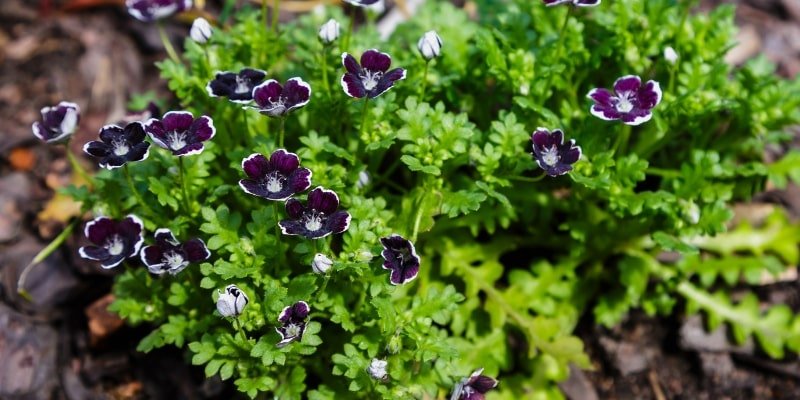
Scientific Name: Nemophila menziesii
Plant Type: Annual
Plant Size: 4-6
Sun Exposure: Full Sun or Partial Sun
Penny Black is a chic, tiny flower with violet, almost black petals that have a thin white border around the outside. A distinctive bud is formed when more white blossoms are in the centre.
These blooms are a variation of the previously mentioned Nemophila Snowstorm flowers, and they go nicely together as opposites. Low-flowering plants like Penny Black’s can be a terrific way to fill in any container or garden bed.
They should draw a large number of benevolent pollinators since they bloom early in the spring. These colourful flowers are easy to grow and will bring you joy.
20. Silver Laced Primrose
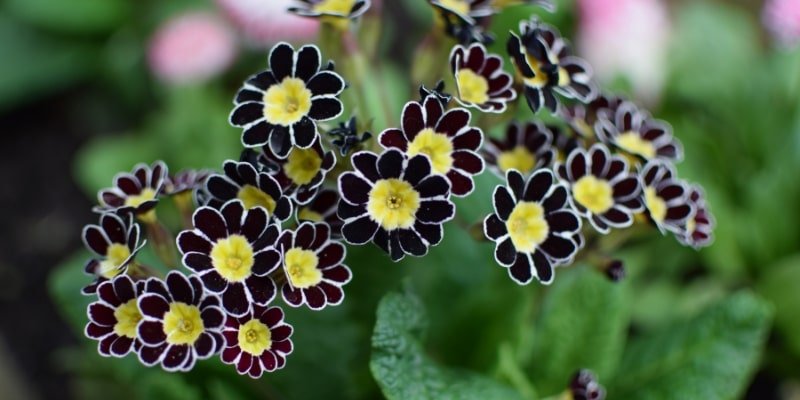
Scientific Name: Primula
Plant Type: Perennial
Plant Size: 6-8
Sun Exposure: Partial Sun to Full Shade
A delightful plant to have white and black blossoms with a pop of colour is the liver-laced primrose. The bright yellow centres of these buds give way to black, and then there’s a line of yellow where the petals end. Their range of colours guarantees that they will provide any garden with a great deal of visual interest.
Plants that grow slowly can be planted in beds or pots. They need fairly wet soil, and they will not thrive in direct sunlight. This is why keeping a watch out for any dangerous slugs trying to get into your flower pots might be beneficial.
Nevertheless, animals and rabbits cannot harm these resilient plants. They’ll be a lot of fun and fragrant.
21. ‘Nigra’ Hollyhock

Scientific Name: Alcea rosea ‘Nigra
Plant Type: Perennials
Plant Size: 5-8 tall
Sun Exposure: Full sun but tolerate light shade
“Blacknight” and “Nigra” are two hollyhock varieties that vie for the title of darkest of all. But in my opinion, it has an advantage over her opponent since its deep purple “blackness” is more reliable and credible, and it has a deep violet undertone that her sister does not.
Large saucer-shaped blooms, about 4 inches (10 cm) across, will begin to open in midsummer from the base of the spike and continue to open for about two months.
When it reaches its towering top (up to 8 feet, or 2.4 meters), this floral display will draw a lot of butterflies, pollinators, and even hummingbirds until mid-season! Underneath the blossoms are large, lobed, rough-looking leaves that stretch outward, giving the impression that they are herbaceous.
Conclusion
Beautiful black and white flowers abound, and each has special advantages of its own. These flowers can be a great way to liven up your window boxes or add some variety to your shade garden. So go ahead and dig out a new spot for any of these flowers and enjoy the gorgeous buds.

